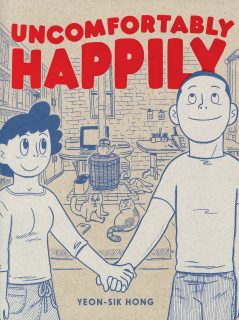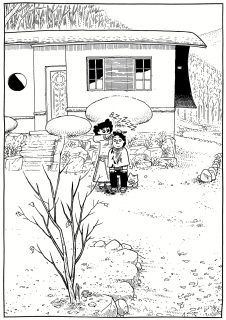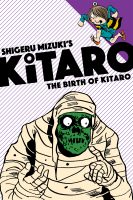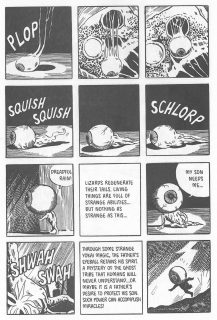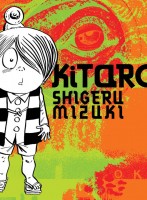 April sales figures are in, and manga continues to dominate the NPD Adult Graphic Novels list. Though the list includes some perennial favorites–Berserk, Demon Slayer, My Hero Academia—Spy x Family saw a big jump in sales after its anime debuted on Crunchyroll last month. ICv2’s Brigid Alverson points out that “April marks the fourth consecutive month that manga has completely filled the chart of the top 20 Adult graphic novels in the book channel.” Manga sales aren’t quite as robust in comic book stores, but three titles made ComicsHub’s Top 20 Graphic Novels for April: Chainsaw Man (4), Kaiju No. 8 (16), and Spy x Family (20). For additional insights into the current state of the manga, check our Madeline Dunnett’s recent post at Anime News Network.
April sales figures are in, and manga continues to dominate the NPD Adult Graphic Novels list. Though the list includes some perennial favorites–Berserk, Demon Slayer, My Hero Academia—Spy x Family saw a big jump in sales after its anime debuted on Crunchyroll last month. ICv2’s Brigid Alverson points out that “April marks the fourth consecutive month that manga has completely filled the chart of the top 20 Adult graphic novels in the book channel.” Manga sales aren’t quite as robust in comic book stores, but three titles made ComicsHub’s Top 20 Graphic Novels for April: Chainsaw Man (4), Kaiju No. 8 (16), and Spy x Family (20). For additional insights into the current state of the manga, check our Madeline Dunnett’s recent post at Anime News Network.
MANGA NEWS
Kodansha just announced the winners of its 46th annual Manga Awards. [Anime News Network]
With less than three weeks to go, Sam Sattin and Guruhiru’s Kickstarter campaign for Unico: Awakening has exceeded its pledge goal of $50,000. The story is “an homage to the God of Manga’s original messaging of social welfare and eco-consciousness.” [Kickstarter]
Good news for Moto Hagio fans: Fantagraphics will be re-printing the first volume of The Poe Clan this summer. While there’s no official release date for the new edition, the long-awaited second volume will be released on July 26, 2022. [Fantagraphics]
Drawn and Quarterly will be publishing Nejishiki, an anthology of short stories by Yoshiharu Tsuge. Look for it in stores in April 2023. [Drawn and Quarterly]
Earlier this week, Yen Press announced that it will publish Sho Harusono’s Hirano and Kaguira, a spin-off of Sasaki and Miyano. [Yen Press]
Brace yourself: Seven Seas just announced even more new manga licenses! Among the most promising are Polar Bear Café: Collector’s Edition and Ex-Yakuza and Stray Kitten, which is pretty much what it sounds like: a former mobster indulges his softer side by rescuing a cat from the streets. [Seven Seas]
Over at The OASG, Justin and Helen round up the latest anime, manga, and licensing news. [The OASG Podcast]
FEATURES AND INTERVIEWS
Patricia Thang takes issue with the marketing label “manga-inspired,” arguing that “To call a comic ‘manga-inspired’ is akin to me saying, ‘Here’s a painting I did! It’s art-inspired! You’d think (or at least hope) I was joking, right? Because what in the fuck would that even mean?!” [Book Riot]
On the most recent Manga in Your Ears podcast, Kory, Helen, and Apryl dissect two manga by Naoki Urasawa: Sneeze, a short story anthology, and Asadora!, his latest series. [Manga in Your Ears]
Andy and Elliot dedicate the latest episode of the Screentone Club to City Hunter and Goodbye-Eri. [Screentone Club]
Walt Richardson and Emily Myers review the April issue of Shonen Jump. [Multiversity Comics]
The Mangasplainers turn their attention to Kakegurui: Compulsive Gambler, “the smash hit seinen manga that pits trust-fund-teens against one another in battles that cause embarrassment and ecstasy, skirting the line between schadenfreude and sadism!” [Mangasplaining]
As the spring anime season kicks into gear, Silvana Reyes Lopez recommends fifteen “unmissable” manga adaptations, from Chainsaw Man to Kakegurui Twin. [Book Riot]
Wondering what to read after Black Clover wraps up later this year? Christian Markle has a few recommendations. [Honey’s Anime]
Brianna Lawrence argues that Death Note Short Stories is more than just a sequel or a companion to the original series; it’s a thoughtful exploration of “how the government would react if such a terrifying weapon was available.” [The Mary Sue]
In an interview with TCJ’s Alex Deuben, Ken Niimura discusses his latest work, Never Open It: The Taboo Trilogy, which re-tells three of Japan’s most famous folk tales. “What I like about these stories… is that they’re pretty open ended,” Niimura explains. “They can be interpreted in many different ways. For example, there’s what’s considered to be the standard version of ‘The Crane Wife,’ but there are actually different versions depending on the region, the era, with many differences to the characters, the ending, etc…” [The Comics Journal]
REVIEWS
Readers in search of “hallucinogenic” stories might want to check out Keiichi Koike’s Heaven’s Door: Extra Works. “In some of these stories, the scale is pure Akira, but the detail and fluidness of the line are absolutely Moebius,” reviewer James Hepplewhite opines. Speaking of over-the-top manga, Megan D. revisits one of the most ludicrous series Tokyopop ever published: The Qwaser of Stigmata. (No, really; this manga goes to eleven.)
- After School!, Vols. 1-2 (Krystallina, Daiyamanga)
- Apollo’s Song (SKJAM, SKJAM! Reviews)
- A Bride’s Story, Vol. 13 (Sakura Aries, The Fandom Post)
- Bungo Stray Dogs Wan!, Vol. 1 (Rebecca Silverman, Anime News Network)
- A Centaur’s Life (Megan D., The Manga Test Drive)
- Dead Mount Death Play, Vol. 7 (Josh Piedra, The Outerhaven)
- Death Note Short Stories (Joseph Luster, Otaku USA)
- Death Note Short Stories (Kate Sánchez, But Why Tho?)
- Dissolving Classroom (King Baby Duck, Boston Bastard Brigade)
- Dr. STONE, Vol. 21 (Marina Z., But Why Tho?)
- Eclair Bleue, Eclair Rouge, and Eclair Orange (Jaime, Yuri Stargirl)
- Hinowa ga CRUSH!, Vol. 6 (Josh Piedra, The Outerhaven)
- Hinowa ga CRUSH!, Vol. 6 (Krystallina, The OASG)
- I Want to Be a Wall, Vol. 1 (Danica Davidson, Otaku USA)
- Little Miss P: The Fourth Day (Demelza, Anime UK News)
- Love of Kill, Vol. 7 (Krystallina, The OASG)
- Made in Abyss (Harry, Honey’s Anime)
- Magic Artisan Dahlia Wilts No More, Vol. 1 (Justin, The OASG)
- The Magical Revolution of the Reincarnated Princess and the Genius Young Lady, Vol. 1 (Sakura Eries, The Fandom Post)
- Marionette Generation (Megan D., The Manga Test Drive)
- Moriarty the Patriot, Vols. 6-7 (King Baby Duck, The Boston Bastard Brigade)
- The Music of Marie (Krystallina, Daiyamanga)
- Our Colors (Publisher’s Weekly)
- Our Teachers Are Dating, Vol. 4 (Erica Friedman, Okazu)
- Our Teachers Are Dating, Vol. 4 (Jaime, Yuri Stargirl)
- The Royal Tutor, Vol. 16 (Sakura Eries, The Fandom Post)
- Seimaiden (Megan D., The Manga Test Drive)
- Spy x Family, Vol. 7 (Rebecca Silverman, Anime News Network)
- The Transcendent One-Sided Love of Yoshida the Catch, Vol. 1 (Rebecca Silverman, Anime News Network)
- Walkin’ Butterfly (Megan D., The Manga Test Drive)
